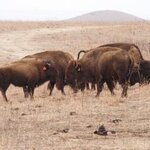Ecology & Zoology

A new study used mathematical modeling and experiments on ants to show that a group is capable of developing flexible resource management strategies and characteristic responses of its own.
Group-living animals are led to regulate their activity and to make decisions on how to manage resources, under the action of a variety of environmental stimuli and of their intrinsic interactions. The latter are typically cooperative, in the sense that the activity of a single animal increases nonlinearly with the number of already active ones.
The researchers from Uppsala University and…

An assistant professor in the Division of Biology at Kansas State University is projecting that grazing animals such as bison and cattle will get smaller due to global warming in the Great Plains.
The conclusion came about by comparing bison in cooler, wetter regions with those in warmer, drier regions. For example, the average 7-year-old male bison in South Dakota weighed 1,900 pounds, while an average 7-year-old male bison in Oklahoma -- a warmer region -- weighed 1,300 pounds. The cause: grasses in the southern Great Plains have less protein than grasses in the northern Great Plains…

Our internal circadian clock regulates daily life processes and is synchronized by external cues, the Zeitgeber, with the main cue being the light-dark cycle.
But the light-dark cycle effect is largely reduced in extreme habitats such as in the Arctic during the polar summer. Using a radiotelemetry system a team of researchers from the Max Planck Institute for Ornithology have now found, in four bird species in Alaska, different daily activity patterns ranging from strictly rhythmic to completely arrhythmic. These differences are attributed to the species' mating systems and behaviors. Their…

Air pollution is related to forest decline and also appears to attack the protecting wax on tree leaves and needles, say scientists who have now discovered a responsible mechanism: particulate matter salt compounds that become deliquescent because of humidity and form a wick-like structure that removes water from leaves and promotes dehydration.
Wax helps to protect leaves and needles from water loss.
Nature conservationists call it a "lingering illness" and the latest report on the North-Rhine Westphalian forest conditions confirms ongoing damage. The researchers found that salt…

Fracking, which mines natural gas using horizontal, hydraulically fractured wells, is widespread across Pennsylvania, with high-volume horizontal hydraulic fracturing (HVHHF) from the Marcellus and Utica shales covering up to 280,000 km² of the Appalachian Basin.
A new paper in the Annals of the New York Academy of Sciences by Dr.Erik Kiviat, of the Hudsonia ecology group, says that natural gas wells are a threat to biodiversity, including pollution from toxic chemicals, the building of well pads and pipelines, and changes to wetlands.
Kiviat cites physical and chemical impacts of…
Parasites comprise a large proportion of the diversity of species in every ecosystem but they are rarely included in analyses or models of food webs. Would it make a difference?
A new paper says that
including parasites does alter the structure of food webs, but that most changes occur because of an increase in diversity and complexity, rather than from unique characteristics of parasites.
A group of researchers, including parasitologists and food web ecologists, analyzed highly resolved datasets for seven coastal estuary and marine food webs. They compared three versions of each food…

A new species of tiny blenniiform fish has been discovered in the southern Caribbean. Haptoclinus dropi is only around 2cm in length with a color pattern that includes iridescence on the fins.
The proposed common name of the species is four-fin blenny, due to the division of the dorsal fin into four sections, which is a distinguishing feature of the genus and unique among blenniiform fishes.
This beautiful new species was discovered as a lucky bycatch during targeted specimen catching at 157-167 m depth off Curaçao as a part of the Smithsonian Institution's Deep Reef Observation…

Many seeds germinate in the soil and get their nutrition in the dark from limited reserves of starch and lipids, so as soon as possible they grow toward light. Light-sensing proteins find the shortest route to sunlight – and then plants are even able to bend in the direction of the light source.
The movements of plants were described comprehensively by Charles Darwin in 1880 in "The power of movement in plants" and the hypothesis that the plant hormone auxin could play a role in plants bending toward a light source was first proposed in 1937 by the Dutch researcher Frits Went in…
Depending on the species, males have different strategies to try and insure that they reproduce, rather than just being a step-parent.
They may try to ensure paternity by increased surveillance and fighting off the competition, they may have more frequent sex with their long-term partners, they may physically punish unfaithful females or refuse to parent potentially unrelated offspring.
Reed warblers (Acrocephalus scirpaceus)
are socially monogamous, defend their territory, and both parents care for the offspring. Scientists recently tried to experimentally test the behavior of…

The greater wax moth (Galleria mellonella of the family Pyralidae) is capable of sensing sound frequencies of up to 300 kHz, making it possessor of the highest recorded frequency sensitivity of any animal in the natural world.
Humans are only capable of hearing sounds from 20 Hz up to around 20 kHz maximum and that drops as we age, while our pets can hear at higher frequencies (leading to concern about things like the hum from ballasts in CFL bulbs) but even dolphins, famous for their ultrasound, only cap out at around 160 kHz.
Male wax moths produce sound with tymbals located on the forewing…